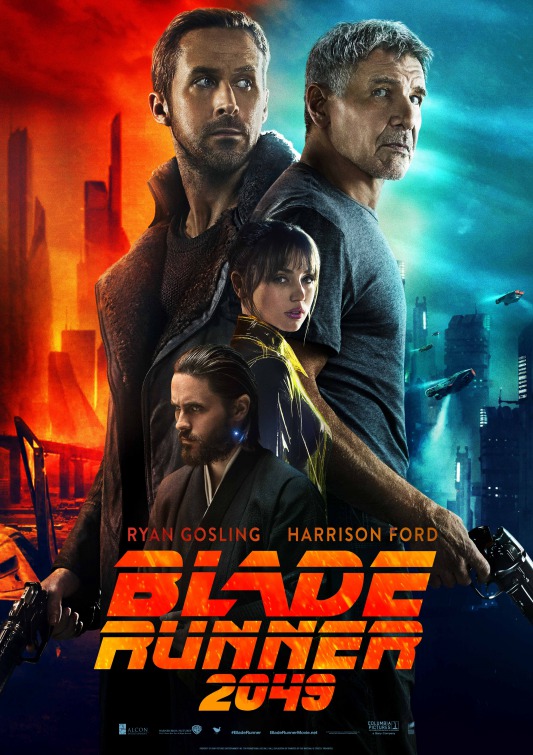
![]() Could we be in a golden age of sequels? I need to rethink my former convictions. Perhaps long-delayed continuations of old movies can be more than crass attempts to make money. Apparently, they can be an artistic triumphs in their own right. Mad Max: Fury Road was a cinematic achievement and The Force Awakens recaptured the spirit of the original Star Wars trilogy. Now Denis Villeneuve has taken on Ridley Scott’s Blade Runner and, if you haven’t figured out from my positive introduction, it’s a magnificent extension of an iconic classic.
Could we be in a golden age of sequels? I need to rethink my former convictions. Perhaps long-delayed continuations of old movies can be more than crass attempts to make money. Apparently, they can be an artistic triumphs in their own right. Mad Max: Fury Road was a cinematic achievement and The Force Awakens recaptured the spirit of the original Star Wars trilogy. Now Denis Villeneuve has taken on Ridley Scott’s Blade Runner and, if you haven’t figured out from my positive introduction, it’s a magnificent extension of an iconic classic.
Blade Runner cemented the cyberpunk aesthetic that would be utilized for a generation of sci-fi films. Its impact was legendary. This sequel picks up 30 years later but continues this thought. Bioengineered humans called replicants have been integrated into society. They are still being treated like second-class citizens, however. KD6.3-7 or K for short (Ryan Gosling) is one of these synthetic humans who works for the LAPD. Gosling is in Drive /Only God Forgives mode. He’s detached, showing little emotion or feelings. It makes sense. He’s a robot after all. He was created to “retire” older models that have been deemed a danger to civilization. In a routine investigation, K discovers the skeletal remains of what appears to be an android who died while giving birth. The ability for replicants to reproduce was thought to be impossible. This development is considered dangerous by K’s superior, Lieutenant Joshi (Robin Wright). She orders him to find and eliminate the child.
Blade Runner debuted in 1982 with a theatrical cut that has been both embraced and rejected over the ensuing years. The original favored a happier ending than the subsequent one that Scott proffered. There have actually been no less than 7 different versions that have been exhibited over the years. The most notable alternative is the 2007 Final Cut that was overseen by director Ridley Scott himself. His Final Cut eschewed the voice-over narration that clarified the focus of the narrative. Additionally, whether the main character Deckard was a replicant himself, is less ambiguous in The Final Cut. The question was, given the disparate endings, which interpretation would Villeneuve’s movie follow-up?
The brilliance of Denis Villeneuve’s vision is that he honors all of these variants by being purposefully ambiguous in his sequel. (He personally professed his love for the 1982 US theatrical edit in a recent interview.) You could have seen any one of these versions and Blade Runner 2049 will still make sense. In fact, I dare say that it is imperative you do see either the 1982 theatrical release or the 2007’s The Final Cut before seeing this picture. You will understand it regardless. However, it lays the groundwork for you to have an emotional connection to the new extension. What does it mean to be human? The original was a slow moving, meditative rumination on the nature of humanity. It was as exquisite as it was ambiguous. Blade Runner 2049 is a fittingly gorgeous continuation of the same themes. Denis Villeneuve could have delved into explaining unanswered questions from the first film. The famous “Tears in Rain” speech is a baffling mix of prosaic exposition. Nevertheless, Villeneuve wisely forgoes giving us lots of answers. Instead, he focuses on expanding the world. It remains somewhat vague but he imbues it with a deeper consideration. Production designer Dennis Gassner and art director Paul Inglis have expanded on the precursor’s approach in creating something reminiscent yet different. We get the flying cars and video advertising with which we are familiar. I’m happy to say ads for Pan Am and Atari have an enduring presence. And as great as everything looks, it sounds even better. The setting has been invigorated with a new score by Hans Zimmer and Benjamin Wallfisch. Some echoes of the Blade Runner theme by Vangelis show up though. The climactic fight is so brazenly cacophonous my heart felt the reverberations of the score.
Blade Runner tantalizes with several supporting characters of note. Harrison Ford returns as Rick Deckard. Not a spoiler. His participation has been well publicized in trailers and posters. He’s not the star, but his relationship with replicant Rachel in the first film becomes a key plot point here as well. His humanity is on full display. Marvel at the martial arts style of Sylvia Hoeks who plays Luv, a killing machine. Meet her boss, replicant manufacturer Niander Wallace. Once again, Jared Leto plays a sociopath character that has less screen time than you were led to believe, but just enough to make an impression. We knew that replicants were outfitted with fake memories, but here we are presented with a visual as to how those memories are put together and assembled. It features Dr. Ana Stelline (Carla Juri) a memory maker creating the presentation of a girl blowing out the candles of a cake at a birthday party. It’s a fascinating scene. And finally, there’s Ana de Armas who plays Joi, a digital simulation of a human that plays K’s love interest. She is perhaps the most important addition. Her shimmering outfits change in seconds emphasizing her ephemeral beauty. One minute she’s K’s live-in girlfriend the next she’s an advertising hologram 20 feet tall in the city square.
Blade Runner 2049 is a stunning looking film. It is a world in which to admire and luxuriate in its style. An urban Los Angeles still looks like a nightmare of neon advertising and endless rain while a bleak and desolate Las Vegas hypnotizes us with a somber spectacle of amber radioactive smog. Rooms with no discernible water source manifest aquatic reflections upon the walls. Holograms are everywhere. Elvis Presley flickers on and off in the interior of a dusty Las Vegas casino. Blink and you’ll miss Marilyn Monroe too. Frank Sinatra appears in a futuristic jukebox singing “One for My Baby.” Director of photography, Roger Deakins captures all this in his usual cinematographic style. At this point, the oft-nominated director of photography has been cited 13 times at the Oscars. It’s a safe bet he’ll be nominated for this as well. At almost three hours, the length of this production is a little problematic. Its melancholy mood has a depressive effect on the viewer. However, it’s never boring. I was transfixed to the screen to see where the story would go as it gradually unfolded. This is not an actioner in the way James Cameron’s Aliens separated itself from the more leisurely paced Alien, (also by Ridley Scott incidentally). Blade Runner 2049 maintains the spirit of the original film. It’s respectful and indebted to the past, but Blade Runner 2049 presents its own identity. It deserves to be a classic as well.
10-05-17

13 Responses
Excellent review Mark ! Loved it equally https://demandedcriticalreviews.wordpress.com/2017/10/07/blade-runner-2049-review/
What a nice surprise right? I’m becoming more and more open to these long gestating sequels to classic films.
Interesting comparison with Star Wars and Mad Max, there’s definitely something in the passion project sequel
Yeah, someone mentioned Creed to me as well. I know that was a critical darling too.
I saw the original, 2 days before and loved it. This version was just as good. A little long, I didn’t care. The whole mood, soundtrack and amazing visuals kept me transfixed to the screen. 4 stars
MY first viewing, I was ok with the length. However, I wonder if that’s because I didn’t know where the story was headed. Now that I do, not sure I’d want to sit and watch for 3 hours.
A long watch, but totally worth it. Nice review.
It was long and that was one of my main gripes. Not too many complaints beyond that. I really enjoyed this.
I was right, a nicely written review as usual. Yes, I haven’t been much of a fan of the incessant obsession of the Hollywood redux, but recent sequels fair better. You mentioned a few key successes like Mad Max and Star Wars. I’m wondering if the upcoming Avatar sequel will feed our brains and hearts.
Avatar 2 is well over 3 years away but I can wait. Avatar was fine but I liked it better when it was called Ferngully/Pocahontas/Dance with Wolves. 😂
I concur.
I don’t know if we’re in the golden age of sequels or if Blade Runner 2049 is a magnificent extension of an iconic classic, but I do agree that Mad Max and The Force Awakens breathed new life into their respective franchises. 2049 is certainly better than I was expecting. I like the direction that it takes the story and the way it expands upon the original. Like you, I also dig the film’s score and feel that it adds a lot to the overall atmosphere. My main issues with the movie are that its plot feels remarkably thin given it’s enormous running time and its languid pacing makes the problem worse. It dips its toes into some interesting sci-fi themes like the manufacture of memories and intimacy with artificial intelligence, but for my money it doesn’t explore them nearly enough to be hailed as a classic.
The plot is thin and the pacing languid, but it shares both those issues with the original. The extreme length didn’t help though. Agreed.